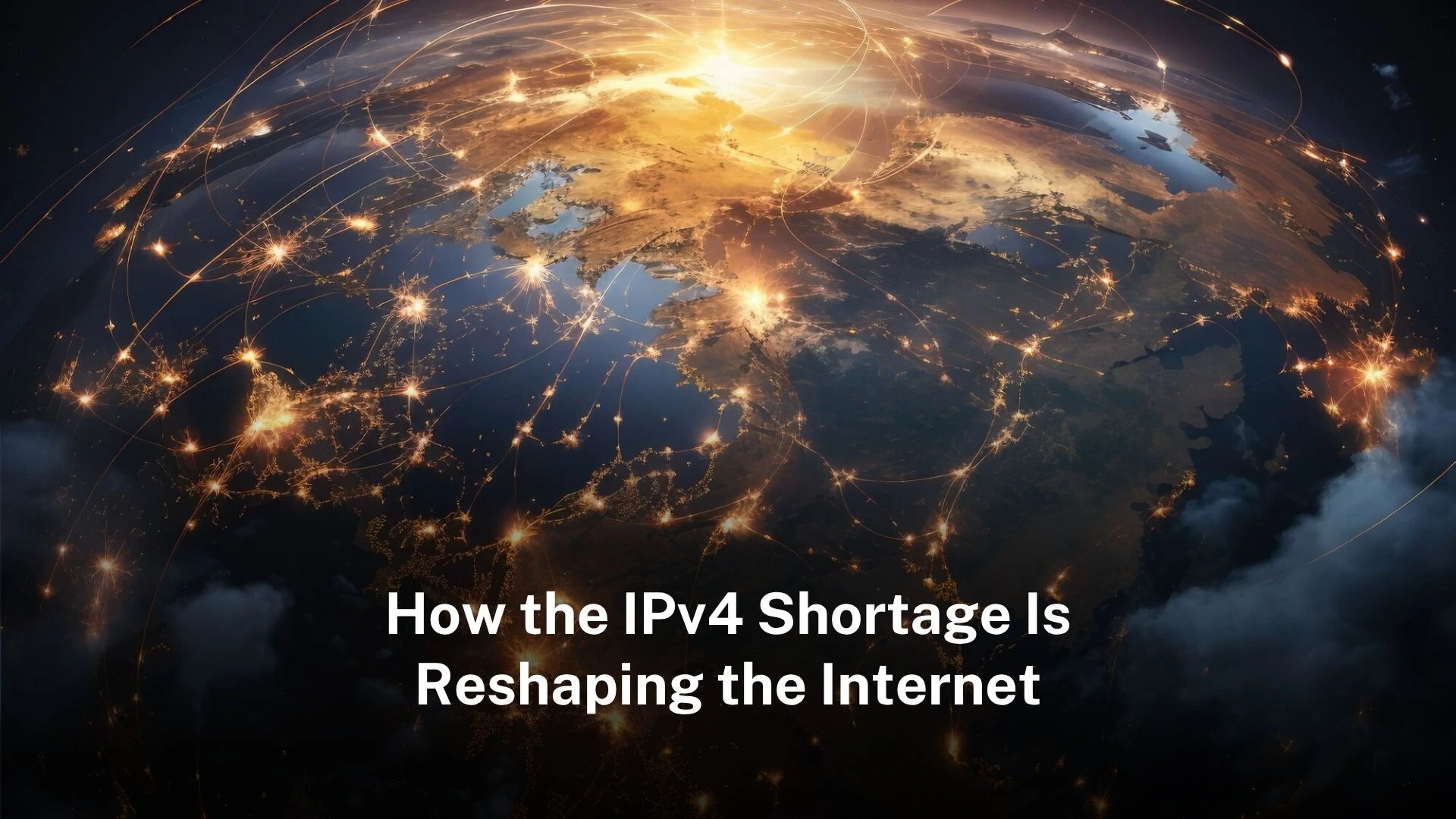How the IPv4 Shortage Is Reshaping the Internet

The Global Depletion of IPv4
Table of Contents
ToggleThe internet was created at a time when no one expected today’s level of growth. When IPv4 came out in the early 1980s, most networks were small. Few people had home computers. There were no smartphones. The number of users was low, and connections were basic. IPv4 was designed with about 4.3 billion addresses, which seemed more than enough.
But the internet grew fast. People connected from homes, offices, and later from mobile devices. Online services appeared one after another. Websites, apps, cloud tools, and video platforms all needed IP addresses. Devices also multiplied. Phones, tablets, smart TVs, and sensors joined the network.
By the 2010s, the five Regional Internet Registries (RIRs)—ARIN, RIPE NCC, APNIC, LACNIC, and AFRINIC—said that their free IPv4 space was gone or almost gone.New companies could not get large address blocks from registries. Only small amounts remained for special cases. The era of free IPv4 ended.
This created a clear shortage. The internet was still growing, but the number of addresses stayed the same. To keep building, companies had to find other ways to get IP space. The shortage did not slow down demand. In fact, it made addresses even more valuable. As a result, IPv4 became a traded digital asset.
The Rise of the IPv4 Secondary Market
When free IPv4 space disappeared, the only option left was to transfer it between users. This created a new type of market. In this secondary market, one party gives up unused addresses, and another buys or leases them. These deals must follow RIR policies. They must also include legal agreements and proof of ownership.
This market was small at first. Most early transfers were between companies in the same region. But as the shortage grew, the number of trades increased. Buyers looked across regions. Sellers became more willing to part with unused space. Brokers stepped in to manage the process. Over time, the market became global.
Prices rose. In 2015, a single IPv4 address could cost $5 to $10. By 2024, prices had reached $50 or more per address. A block of 1,000 addresses could cost tens of thousands of dollars. Some companies even bought millions of dollars worth of space.
This changed how companies view IP addresses. In the past, addresses were tools. Now, they are resources. They affect budgets, strategies, and timelines. Some companies invest in addresses like property. Others lease space when needed. The secondary market is now a central part of internet expansion.
Pressure on Network Management and Engineering
The shortage of IPv4 addresses has changed how networks are built. Engineers can no longer waste space. They must make each address count. In the past, companies gave each office or server farm a large block. Today, they use smaller blocks. They also reuse space more often.
Many networks now use Network Address Translation (NAT). With NAT, several devices share a single public IP. This saves space, but it brings new problems. NAT makes it harder to track traffic. It can break some types of apps or delay connections. Fixing problems in NAT-based networks takes more time.
Some large ISPs use Carrier-Grade NAT (CGNAT). This lets thousands of users share a few addresses. It works, but it lowers performance. Some websites block CGNAT users. Others do not load correctly. This hurts the user experience. Still, many providers must use it. They have no other option.
Network teams must monitor usage all the time. They look for unused space. They move blocks between services. They check logs to avoid conflicts. This adds to their workload. Every system must be tracked. Mistakes can bring outages. IPv4 planning has become a daily job.
Some companies build dual-stack networks. These support both IPv4 and IPv6. This gives more options. But it also adds cost. Dual-stack networks are harder to manage. They need more equipment and more knowledge. Not all staff are trained to handle both protocols. So many firms delay the switch.
The Impact on Cloud Services and Startups
Cloud platforms need large amounts of IP space. They must assign addresses to clients, virtual machines, and hosted services. Major players like AWS, Microsoft Azure, and Google Cloud have enough space. They bought large blocks early or joined the secondary market with strong buying power.
However smaller platforms and startups struggle. They do not have the money to buy big blocks. Leasing helps, but prices are high. Many startups now spend more on IP addresses than on other parts of their network. This slows down product launches. It limits growth.
Some startups build systems that share one IP across many services. Others use third-party tools to hide their shortage. These solutions work, but they bring delays and complexity. In some cases, customers notice poor performance. This damages trust.
The gap between large and small firms is growing. Big companies grow faster because they have enough space. They can launch services in more regions. They do not face as many limits. Smaller firms must wait, plan carefully, or find new workarounds.
This has changed the startup world. Some investors now ask about IP plans. Others value companies with existing address space. The shortage affects not just operations but funding and valuation. Access to IP addresses is a key part of business success.
The Push Toward IPv6
IPv6 was created to solve these problems. It offers a huge number of addresses. Every device can get its own. It removes the need for NAT. It also supports new types of services that rely on direct connections.
Some networks have already moved to IPv6. Google, Facebook, and major ISPs offer IPv6 support. Mobile networks often lead the way. In some countries, IPv6 use is above 50%. But other regions are behind. In some places, fewer than 10% of users have IPv6 access.
One reason for slow adoption is cost. IPv6 requires upgrades. Some routers and software do not support it. Companies must train staff. They must change systems. These changes take time and money. So many networks delay the move.
Another reason is compatibility. IPv4 and IPv6 cannot talk directly. So networks must run both. This is called dual-stack. It is the safest way to migrate. But it doubles the work. It also adds more things that can go wrong. Many companies avoid this.
Even so, IPv6 adoption is growing. Some governments require it. Others offer support or funding. Hardware makers now ship devices with IPv6 by default. Over time, more networks will switch. When that happens, the pressure on IPv4 will drop.
Until then, IPv6 is not a full fix. It helps some networks. But most of the internet still runs on IPv4. That is why the shortage matters.
The Legal and Regulatory Landscape
As the IPv4 market grows, legal issues appear. Who owns an IP block? What happens if a company goes bankrupt? Can space be sold across borders? Different regions have different answers.
Some RIRs treat IP addresses as property. Others see them as shared tools. This affects how transfers work. Some places need proof of need. Others allow free sale. This creates confusion, especially in global deals.
Legal cases have already happened. Some blocks were hijacked. Others were sold without permission. Courts have ruled in different ways. Some companies have lost access. Others have faced long delays.
Governments are also getting involved. Some say IP addresses are part of national networks. Others want to tax address sales. Some countries may limit who can buy space. These moves may slow the market.
“The exhaustion of the free IPv4 pool was inevitable given the Internet's exponential growth.”
— John Curran, President and CEO of American Registry for Internet Numbers (ARIN)
RIRs must update their policies. They must check that transfers follow rules. They must stop fraud and keep records. As more deals happen, this job grows harder. Some RIRs now work with lawyers and auditors. They act as both registry and referee.
Companies must now treat IP space as a legal asset. They must document ownership. They must review contracts. They must track changes. Legal teams play a bigger role in network planning than ever before.
The Growing Role of IP Brokers
Because this market is hard to manage, many companies turn to IP brokers. These brokers help find sellers. They check records. They help write contracts. They work with RIRs to complete deals.
A good broker adds value. They know the rules. They explain the steps. They stop mistakes. Without them, many deals would fail or take months. They help both small and large firms.
Some brokers also offer leasing. Others run IP management services. They deal with spam complaints. They help remove blocks from blacklists. Some handle full address portfolios. Their work goes beyond sales.
As the market grows, the broker’s role grows too. They act as market experts, legal guides, and technical advisors. Their knowledge keeps the system working. Without them, the IPv4 shortage would cause even more problems.
Trusted IPv4 Leasing for Business Growth
Get enterprise-grade IPv4 space quickly, with seamless deployment and end-to-end management.
FAQs
IPv4 only has about 4.3 billion addresses. As more people, devices, and services joined the internet, those addresses ran out. No new IPv4 space is left in the registry system.
IPv6 needs new systems, training, and updates. It also does not work directly with IPv4. So many networks run both. This is costly and complex, so some delay the switch.
Yes, but not from RIRs. You must buy or lease them from others. Most deals go through brokers and follow strict registry rules.
There are risks like fraud, bad records, or blacklisted space. If you skip checks, you may lose money. A trusted broker helps avoid these problems.
Yes, in the long term. IPv6 gives almost unlimited space. But adoption is slow. Most networks still need IPv4. The shortage will last for years.
